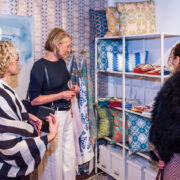Explore some of the most iconic pieces by American designers in the midcentury.
Throughout the years, we’ve seen these legendary pieces frequently imitated yet never fully replicated. They stand as artifacts, embodying the creativity and innovation of American designers pushing the envelope of post-World War II design. Today, we pay tribute to these iconic designs that continue to brighten and inspire living spaces across the world today.
“A classic is something that, every time you look at it, you accept it as it is, and you see no way of improving it.”
Warren Platner (1919–2006), architect and interior designer
Eames Lounge Chair and Ottoman (1956) by Charles and Ray Eames
The archetypal Eames Lounge Chair and Ottoman, first introduced in 1956, originated from Charles & Ray Eames’ vision to craft a chair with “the warm, receptive look of a well-used first baseman’s mitt.” This design truly captures the essence of relaxation. Since its debut, the chair has been in continuous production and stands today as one of the most significant furniture designs in history.
Womb Chair (1948) by Eero Saarinen
Eero Saarinen created the groundbreaking Womb Chair at the request of Florence Knoll, who wanted “a chair that was like a basket full of pillows- something she could really curl up in.” This classic supports various positions and provides a comforting oasis of calm, perfectly justifying its name.
Noguchi Coffee Table (1947) by Isamu Noguchi
In 1939, Noguchi created a small model table for designer T.H. Robsjohn-Gibbings, only to later find a variation of it advertised without credit. Upon confronting Robsjohn-Gibbings, he was told “anybody could make a three-legged table,” prompting Noguchi to design his own version. This design was used to illustrate an article by Herman Miller designer George Nelson, ultimately becoming Noguchi’s famous coffee table.
Tulip Chair (1955-1956) by Eero Saarinen
The Tulip Armchair, resembling both a flower and a stemmed wine glass, is part of Saarinen’s final furniture series, designed to reduce clutter. His goal was to simplify and clarify structure, aiming to eliminate the “slum of legs” typical in furniture design. Each piece in the Tulip series features a single pedestal leg, creating a unified look.
Wire Chair (1951) by Charles and Ray Eames
In the 1950s, Charles and Ray Eames began experimenting with bent and welded wire, drawing inspiration from trays, dress forms, and baskets. The Eames Office developed several pieces, including a wire version of the single shell form. This shell design combines a transparent lightness yet remains sophisticated.
Platner Collection (1966) by Warren Platner
Warren Platner brought a deep understanding of architecture to his designs, creating something unique compared to modernists before him. The Platner Collection marked a cultural shift towards a more expressive Modernism, blending decorative elegance with rational design. Featuring sculptural tables and chairs made from hundreds of cylindrical steel wire rods, the collection embodies both structure and ornamentation.
LCW (Lounge Chair Wood) (1946) by Charles and Ray Eames
During World War II, Charles and Ray Eames developed inexpensive wood molding techniques, leading to the creation of plywood chairs like the LCW. Designed for optimal comfort without upholstery, the LCW used rubber shock mounts for a clean look without the use of bolts or screws. Their goal was to produce affordable, high quality chairs for the masses.
Bertoia Diamond Chair (1952) by Harry Bertoia
Harry Bertoia, known for his bronze sculptures, used his metalwork expertise to create the Diamond Chair for Florence Knoll. From 1947 to 1950, he conducted early ergonomic research at a Navy lab, learning to design for the human form. This led to his lightweight wire chair, whose seat conformed to the body, focusing on space, form, and the characteristics of metal.
Marshmallow Sofa (1956) by George Nelson
George Nelson and Irving Harper, working in Nelson’s design firm, were approached by an inventor with a durable, inexpensive injection plastic disc. Inspired, they arranged 18 of these discs on a steel frame, creating the origin of the Marshmallow sofa. Although the inventor’s cushions were impractical, Herman Miller decided to manufacture the sofa. The design, with its floating, separate elements, paved the way for the pop art style of the 1960s.
Bubble Lamp Series (1952) by George Nelson
The Nelson Bubble Lamps bring softness and luminosity to any given space. Inspired by expensive silk covered Swedish lamps, Nelson created the Bubble Lamps using a translucent white plastic spray developed by the U.S. military. He drew from organic shapes to design variations like the Apple Bubble Pendant, Pear Wall Sconce, Lotus Table Lamp, and Saucer Pendant Lamp.





